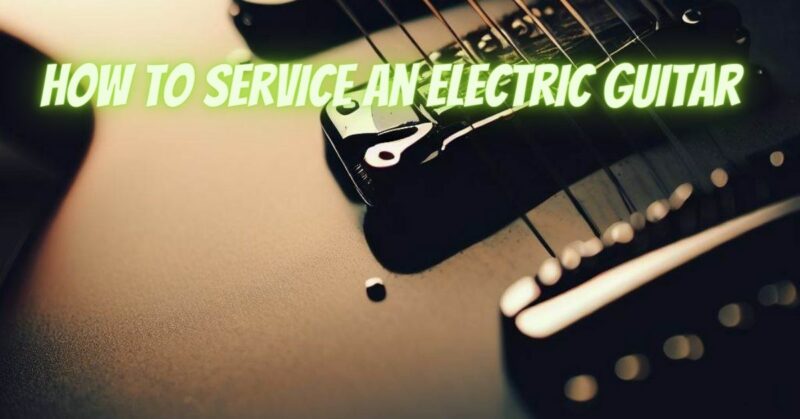An electric guitar is not just a musical instrument; it’s a tool that allows you to express your creativity and artistry. Like any precision instrument, regular maintenance and servicing are essential to ensure your electric guitar performs at its best. Whether you’re a seasoned guitarist or a beginner, learning how to service your electric guitar can save you money on professional repairs and help you develop a deeper understanding of your instrument. In this article, we will provide you with a comprehensive guide on how to service an electric guitar, covering essential maintenance tasks and troubleshooting tips.
- Cleaning and Polishing
Regular cleaning is the first step to maintaining your electric guitar’s appearance and playability. Use a soft, lint-free cloth to wipe down the guitar’s body, neck, and fretboard after each playing session. Pay special attention to removing any dirt, sweat, or fingerprints from the strings and frets.
Periodically, use a guitar-specific cleaning solution to remove grime and stubborn stains from the guitar’s finish. Additionally, apply a suitable guitar polish or wax to protect the finish and give your guitar a beautiful shine.
- Changing Guitar Strings
Changing guitar strings regularly is vital for maintaining optimal sound quality and playability. Over time, strings can lose their brightness and become prone to breaking. How often you change strings depends on your playing frequency and style, but a good rule of thumb is to replace them every 2-3 months or sooner if they show signs of wear.
When changing strings, clean the fretboard and bridge to remove any accumulated dirt or debris. Restring one string at a time to avoid significant changes in neck tension.
- Adjusting Guitar Action
The action, which refers to the height of the strings above the fretboard, significantly impacts playability. Too high action can make the guitar harder to play, while too low action may cause fret buzz.
To adjust the action, use the appropriate tools to raise or lower the bridge saddles. Make small adjustments, test the playability after each adjustment, and ensure that the frets are level to avoid fretting out.
- Setting Intonation
Intonation ensures that each note rings true and stays in tune throughout the neck. Incorrect intonation can lead to chords sounding out of tune or certain frets being off-pitch.
To set the intonation, use an electronic tuner and adjust the length of the strings at the bridge saddles. Play an open string and then the same string at the 12th fret while comparing the tuner readings. Adjust the saddle position until both readings match.
- Truss Rod Adjustment
The truss rod helps counteract the tension of the strings, affecting the guitar’s neck relief. A properly adjusted truss rod ensures the neck remains straight and allows for comfortable playing.
If your guitar’s neck has excessive bow or backbow, a truss rod adjustment may be necessary. It’s crucial to follow the manufacturer’s guidelines and make small adjustments, as improper truss rod adjustments can damage the neck.
- Electronics and Wiring
Check the guitar’s electronics and wiring for loose connections, crackling pots, or any other issues. Use contact cleaner to clean dirty potentiometers and switches. If there are any loose wires, solder them back into place or take your guitar to a professional for repair.
- Check and Lubricate Hardware
Regularly inspect the guitar’s hardware, including the tuning machines, bridge, and nut. Tighten any loose screws or bolts, and lubricate any moving parts with appropriate guitar-specific lubricant to ensure smooth operation.
Servicing an electric guitar is an essential skill that every guitarist should possess. Proper maintenance and regular servicing not only keep your instrument in top shape but also improve playability and sound quality. By learning to clean and polish your guitar, changing strings, adjusting the action, setting intonation, making truss rod adjustments, checking electronics and wiring, and lubricating hardware, you can keep your electric guitar performing at its best for years to come. Whether you’re a hobbyist or a professional musician, taking care of your instrument will undoubtedly enhance your playing experience and allow you to create music with confidence and precision.


